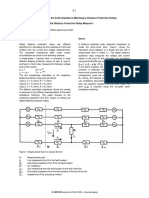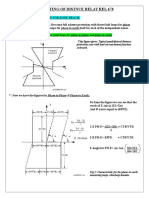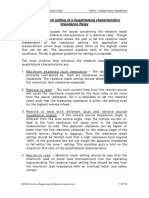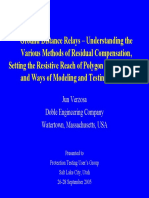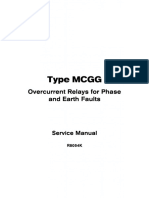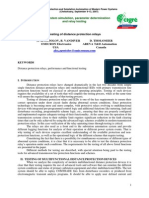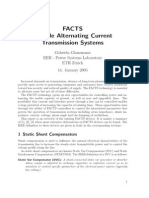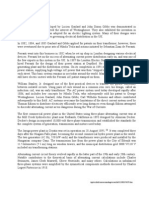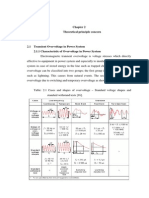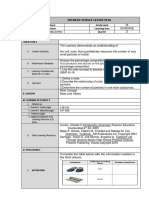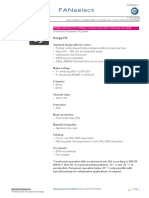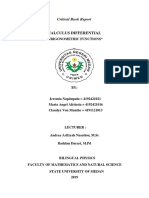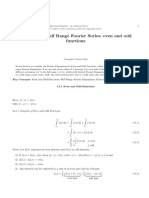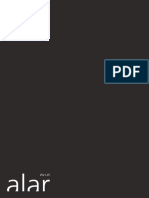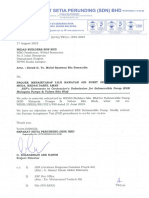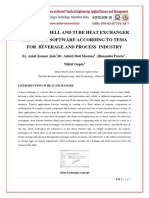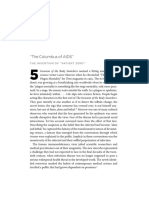Introduction to System Protection - Protection Basics and Terminology
Hands-On Relay School
Jon F. Daume Bonneville Power Administration (Retired) March 14, 2011
1
�A Reference
for the
Rest of Us!
Hands-On Relay School March 14, 2011
�Purpose of Protective Relays
Transmission line fault protection Detect and isolate equipment failures Improve system stability Protect against overloading Protect against abnormal conditions Voltage, frequency, current Protect public
�Fault Causes
Lightning Wind and ice Vandalism Contamination External forces
Cars, tractors, balloons, airplanes, trees, critters, flying saucers, etc.
Equipment failures System disturbances
Overloads, system swings
4
�Fault Types
One line to ground (most common) Three phase (rare but most severe) Phase to phase Phase to phase to ground
�Single Line to Ground Fault
Vc
Va
Vb
Ia
7
�Three Phase Fault
Ic Ib Vc Va
Vb
Ia
8
�Phase to Phase Fault
Vc Ic
Va Ib Vb
�Two Phase to Ground Fault
Ic
Vc Ib Va Vb
10
�Balanced & Unbalanced Systems
Balanced System: 3 Phase load 3 Phase fault Unbalanced System: Phase to phase fault One line to ground fault Phase to phase to ground fault Open pole or conductor Unbalanced load 11
�Balanced & Unbalanced Systems
C C
A A
Balanced System
B Unbalanced System
12
�Sequence Quantities
(Symmetrical Components)
Condition
3 Phase load 3 Phase fault Phase to phase fault One line to ground fault Two phase to ground fault Open pole or conductor Unbalanced load
+
� � � � � � �
� � � � �
0
� � � �
13
�Relay Types
Non-directional
Detect fault in any direction
Operate when quantity exceeds pickup value Used on distribution lines Can be used on radial systems
Directional
Only trip for faults in front of relay (on line)
Use voltages, currents, angles to determine fault direction Operate when quantities exceed pickup value and correct direction is determined Relay of choice for HV and EHV transmission
14
�Relay Types
Current, voltage, frequency
Operates if input meets setting
Distance
Uses voltage and current to measure impedance to fault
Differential
Looks at imbalance between inputs Common for power transformers and generators Can be used for transmission lines
15
�Relay Types
Recloser
Relay to automatically reclose circuit breaker following a relay operation to restore circuit
Pilot scheme
Uses communications to transmit relay information or trip to remote terminal Provides high speed tripping for entire protection zone Radio, fiber optics, hard wire, carrier current can be used for pilot channel Most common on HV, EHV lines
16
�Relay Types
Phase relay
Relay measures phase current or voltage quantities
Ground relay
Relay measures ground current or voltage quantity (zero sequence values) Protects for one line to ground and phase to phase to ground faults
Sequence relay
Relay measures symmetrical component sequence quantity (+, -, 0)
17
�Relay Trip Times
Instantaneous
Relay operates as soon as operating value is met
Time delay
Relay operating time is delayed Fixed delay determined by separate timing element (62) Inverse delay determined by magnitude of operating quantity and relay operating curve
Delay decreases as operating value increases
Actual clearing time includes relay operate time plus circuit breaker opening time
18
�Relay Construction
Electromechanical
Several individual relays required for complete fault protection
Static or electronic
One or more relays required for complete fault protection
Digital or microprocessor
Single device provides complete fault protection Device may include additional features not available with electromechanical or electronic relays
19
�Relay Basics
Component relay
Individual boxes that provide phase or ground protection, reclosing, etc.
Relay system
Bunch of single components designed to do a task A multifunction device to do the same task or several tasks
20
�Digital Relays
Digital relays were introduced in early 1980s Additional digital relay features
Fault information and location Voltage and current inputs required to locate fault Remote communications Self testing Circuit breaker history and monitoring Metering Time tagging (GPS clock input)
Concerns
Complicated to apply (many elements) Single point of failure Limited life expectancy
21
�IEEE Device Numbers
Numbers 1 - 97 used 21 Distance relay 25 Synchronizing or synchronism check device 27 Undervoltage relay 32 Directional power relay 43 Manual transfer or selector device 46 Reverse or phase balance current relay 50 Instantaneous overcurrent or rate of rise relay (fixed time overcurrent) (IEEE C37.2)
22
�IEEE Device Numbers
51 52 59 62 63 67 79 81 86 87 AC time overcurrent relay AC circuit breaker Overvoltage relay Time delay stopping or opening relay Pressure switch AC directional overcurrent relay AC reclosing relay Frequency relay Lock out relay Differential relay (IEEE C37.2)
23
�Relay Reliability
Overlapping protection
Relay systems are designed with a high level of dependability This includes redundant relays Overlapping protection zones
We will trip no line before its time
Relay system security is also very important Every effort is made to avoid false trips
24
�Relay Reliability
Relay dependability (trip when required)
Redundant relays Remote backup Dual trip coils in circuit breaker Dual batteries Digital relay self testing Thorough installation testing Routine testing and maintenance Review of relay operations
25
�Relay Reliability
Relay security (no false trip)
Relay security failures have increased the impact of numerous system disturbances Careful evaluation before purchase Right relay for right application Voting
2 of 3 relays must agree before a trip
Thorough installation testing Routine testing and maintenance Review of relay operations
26
�Protection Zone
Portion of system protected by relay Usually determined by location of current transformers Common protection zones
Substation bus Transmission line
May have multiple protection zones
Power transformer Generator
Common to have backup protection for zone
27
�Instrument Transformers
Used to transform line currents and voltages to relay values
Voltage and current transformers
Transformer types
Magnetic Capacitive
Capacitor voltage divider to measure voltages
Optical
28
�Instrument Transformers
Transmission Lines
Zsecondary = Zprimary x CTR / VTR
For distance relays
The PT location determines the point from which impedance is measured. The CT location determines the fault direction.
CT location generally determines zone of protection
29
�CT Selection
C800 Current Transformer
Will support 800 volts @ 100 amps on CT secondary before saturation (20 times rated secondary current) Consider burden of relays and cable impedance
CT Accuracy decreases when less than full winding used
At half ratio, CT is C400
CT Saturation:
Saturation most severe with high magnitude faults
30
�Saturated Current
150 100 50 0 -50 -100 -0.017
0.000
0.017
0.033
0.050
0.067
31
�UFOs vs. Power Outages
32
�Jon F. Daume Bonneville Power Administration Electrical Engineer (retired) System Protection & Control, March 14, 2011
33



